Bussy Temple is a queer party collective in Singapore that began throwing renegade raves for their friends in a spooky tunnel with an abandoned train track running through it. Somewhere in the outskirts of the island, they’d gather their friends around a table with a laptop and portable speakers, throwing up chintzy club lights on the tunnel’s aluminum walls. It was early 2022, and these kinds of parties simply did not exist in a country where any hints of deviance are highly discouraged by the powers-that-be, and a pervasive paranoia of punishment keeps most citizens with their heads down in obedience. But as the crew and their friends stripped off clothing in the tropical heat and screamed along to hard dance edits of Whitney Houston, they knew they’d found a temporary respite from the state’s iron grip—and so, they kept dancing.
In 2023, when I decided to film the pilot of Rave New World’s docuseries on global rave culture in Singapore, my home country, everyone said that my film crew should shoot the scene at Bussy Temple. So we did, and the results were finally cut into an mini-documentary that we screened last month in Singapore, at a chic new club called Rasa (which itself is an interesting story that you can read about here).
After the screening, I had the chance to sit down with two members of the Bussy Temple collective, resident DJ Bruce (aka howrøng), and Jo Ho in front of a live audience. We talked about queer cybernetic theory and how it relates to Singapore’s technocratic state, how they got away with throwing a renegade, and why there’s a bit of a lull in the country’s rave scene right now.
In the second half of the conversation (around 24:44), Bruce plays and discusses a couple tracks that have been in heavy rotation at the party, giving us a taste of the hardcore sounds of Southeast Asia’s underground.
Check it out, and if you like this video format and want to see more conversations like this, please hit the “like” button and consider bumping up to a paid subscription—as always, THANK YOU for being here!!
Michelle Lhooq: Hi everyone. So we're here today with Bruce aka howrøng and Joho, co-organizers of Bussy Temple, these incredible cyberpunk, brave, queer, fabulous festivities happening in Singapore. We wanted to talk a bit more about the complexities of throwing a rave in Singapore, as well as get into some really interesting theory behind the party around… let's call it queer, cybernetic transhumanism. And then Bruce is going to play us some songs that represent the sounds of Singapore and Southeast Asia's Underground. So it's going to be really fun.
I wanted to start by reading the introduction to the party that Rave New World's documentary was about, called Xenoflesh. It happened in December 2023, and it really caught my attention, because you don't find screeds this on Eventbrite very often:
i dream of a blasphemy. we come from surrogate wombs, gestated by our own hands. the haraway cyborg emerging beyond holy dualisms now archaic: i am nature-machine-human-animal-the ideal-the material.
metamorphosis is moot, change is our only god. our limbs detachable, pharmaco-interventions abound. synapses rush thoughts from the other side of the net into our consciousness.
in me is the universe, delivered through data. our bodies an altar, a home for multiplicities: embodying i—you—networks—pulses—what has been—what will be—an infinite interflow of subjectivities…a mutant queer future
I mean, that is rave poetry. Did you write that, Jo?
Jo Ho: We all write the initial concept together. And then Minsoo, who actually is a writer, comes in and edits our ideas and phrases into something more poetic and narrative. But I haven't heard this in so long, a year. It's crazy.
Lhooq: So tell me about the concept of the party, Xenoflesh. What is this text about? What are you trying to gesture at?
Jo Ho: Maybe I can paint a picture of the collective's vibe and the greater community's vibe at that time, and then I'm actually going to read something that Minsoo wrote for us because she couldn't be here. She's in New York, and she saw the first premiere [of the Rave New World documentary on Singapore there].
During this time, we were doing a lot of raves that were very hard, and it's about the release of energy. Xenoflesh was our conclusion to this streak of rebellion in expression, right? Expressing ourselves as much as we want within the space and trying to integrate different types of self expressions. We always integrate using tech to increase empathy between each other, or connect with each other in different ways. We have our phones, we’re basically (already) connected to tech, connecting to each other.
I think I'll just briefly read what Minsoo wrote for us regarding the theory of the Cyborg Manifesto, othering, and cybernetic utopias:
“The concept for Xenoflesh departed from Donna Haraway’s Cyborg Manifesto, a seminal feminist text that inspired the xeno-feminist school of thought, where the party name is partly from. In it, she employs the cyborg as a means of turning away from the constant creation of the “other,” the “other” meaning the thing that's assumed not to be the subject. So the way that subjugation and antagonism, whether towards women or nature or anything else that we regard as the “other,” comes to be justified—she proposes a blending of boundaries instead. So also Bussy Temple, we're all about the in-between. It's not boy, it's not pussy, it's bussy. It's not girl, it's not boy, it's non-binary. We always want to live in the in-between.
Through this concept, we also wanted to explore the role of technology and utopian imaginations, which we always do with all of our parties. We write narratives for them, and we try to build a piece of that world within the narrative. Tech is often employed to enable an escapist alternate reality—fantasy as an answer to dystopia. What if it could be imagined as a thing that makes us one? Thoughts and emotions of millions of subjectivities coursing through data with consciousness, uniting us, breathing in one. Technology as a means to ultimate, visceral oneness, blurring of boundaries. Taken to its extreme, technology facilitating empathy, rather than a disparate, disassociated escapism.”
So I think Xenoflesh also harks back to the fact that we're visceral beings, and we have to live in the bodies that were given. How do we make the most of it? Do we connect with tech more? Do we connect with each other more? How do we hybridize all of these formats? Xenoflesh is a very, very big concept. And of course, anyone can interpret it in the way that they want to read it based on their own experiences.
Lhooq: I love how intellectual the concept of this party is. It feels very Singaporean, actually, , , over-conceptualizing everything. We're hyper-educated… but still cunty. I love this idea of the mutant queer futures that you talk about in the description, and I'm curious about how you see the relationship between mutant cyborgian identity as well as queerness—is that connected to you?
Jo Ho: Just in your documentary, a lot of people from our community feel very alien here, in this normcore society, where any expression that deviates from the norm can be seen as weird. Why did you bleach your eyebrow? Why did you do that? Why this? Why that? So I think expressing yourself and celebrating a mutant form is something that we really try to push. I mean, you can also come as your normcore self. That's fine, too. That's also a look. But I think we really celebrate that alien energy, celebrate you for who what makes you unique.
As for more theory on cyborgism, or the Cyborg Manifesto, I don't know how else to describe it. I think Minsoo is more of the theorist here. All I can say is, we just want to celebrate that experimentation, going past the boundaries, going past the skin, or going past tech to connect.
Lhooq: I also feel it's a way to get past certain sticky issues around identity politics. It’s like we're pushing past gay, straight, trans, whatever. We're just mutants.
Jo Ho: We always say we're the plus in LGBTQIA+.
Lhooq: I love that. Your party was the first time that I've seen young trans people hanging out together, and that was really powerful to observe in Singapore. When you started the party, were there other queer or trans forward events happening that you took inspiration from? Or were you creating something because you felt there was a vacuum?
Jo Ho: Maybe Bruce can speak on this, because Bruce was in Bussy before I joined.
Bruce: The queer and trans community has always been in Singapore. It's not something new. There's always been events, it's just that they maybe couldn't be so public. And then for Bussy Temple, the lore is that Minsoo and Zenon, aka Metamoksha, used to live together. They were , what should we call our place? Then brainstormed, and I think they got some inspiration from this collective called Pussy Palace. But they were , you know, what should we call it? Maybe it's a temple. So then they thought, oh, BUSSY, BUSSY, PUSSY temple. So it started more , finding a place just to be. It was just a gathering. But then we did our first rave in a tunnel. And I think that that was when it really started. I'm going away from the question, but basically there are queer and trans events, but not raves that played hardcore music, techno or harder forms. So I think in that sense, it was new. At least I didn't know of any other collectives that were queer and trans-forward and also playing hard music.
Lhooq: I’m glad that you brought up the tunnel rave, because that's such a key part of the party's lore. Again, another first for me. I've never heard of anyone throwing a renegade rave in Singapore. Actually, that's not true. Someone told me one time that they went to a rave in an empty swimming pool, which sounded really cool, but it almost feels a myth, right? How is this even possible? How do you get away with it in Singapore, which is so small and so tightly surveilled. I think that people who live outside of Singapore might not understand that it's a really tiny island country, and so it is possible to actually have every single square inch surveilled by cameras. So how did you do that? And were you afraid?
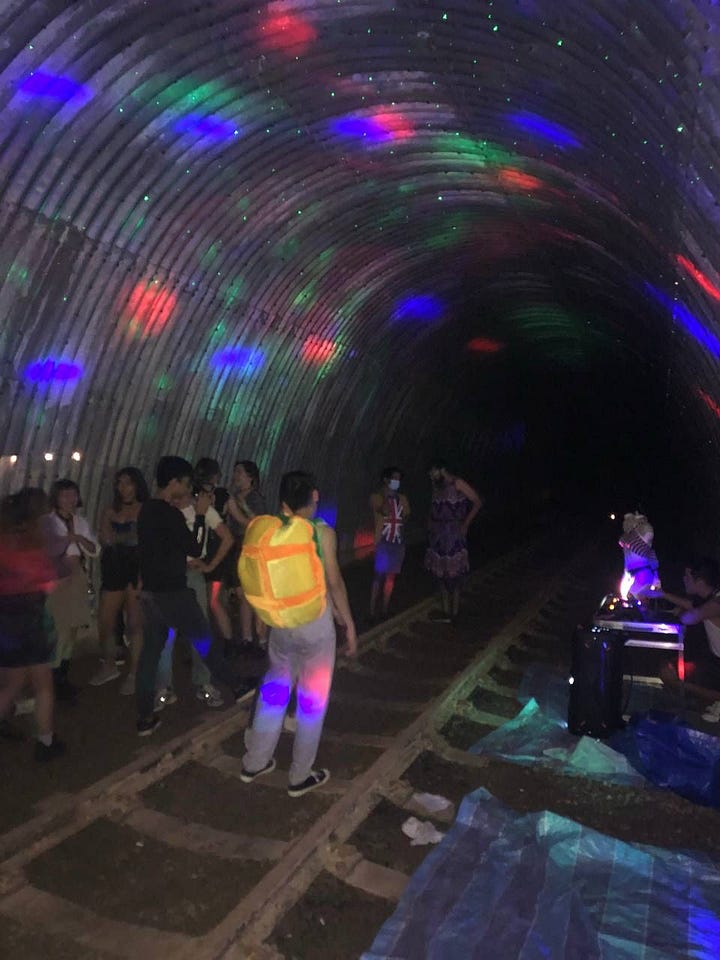
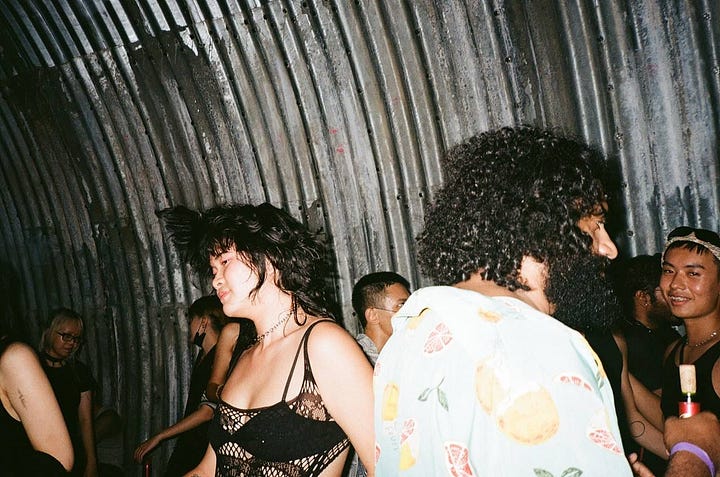
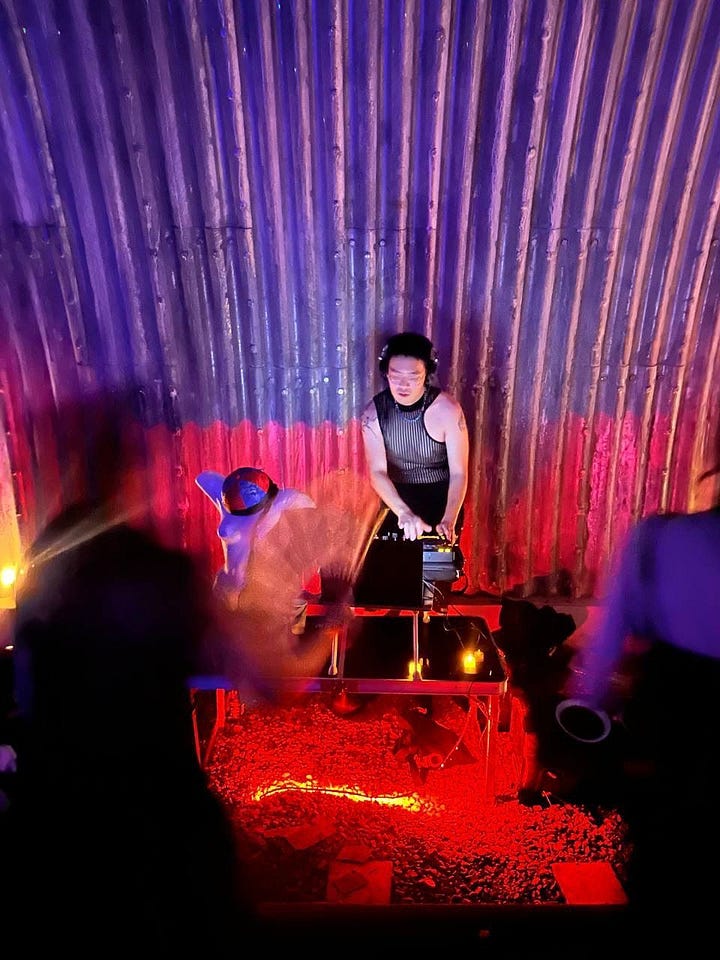
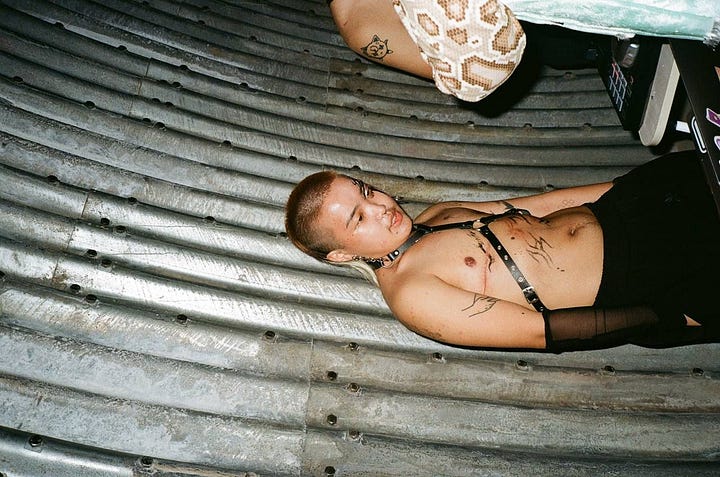
Bruce: Definitely we were scared, but it was a small group, I think that was the first thing. And back then, there wasn't so much attention on raves, because I think in early 2022 there were waves, but it wasn't so, , a TikTok thing, , oh my god, rave, Tiktok, let's go. No, it's just a group of friends. It was really sending this badly made poster with our names on it to our friends through WhatsApp. And then I had to bring my JBL speaker down that muddy hill. It was a whole thing. Because it was so small and tight, we didn't have to worry about word getting out, and we just had some rules, , don't post it online until after. And we had people check because it's a secluded area of Singapore. I'm not going to say where, but it was near a highway and not near any major residences. So that's pretty much how we got away with it.
Lhooq: Did any random Singaporeans come across you?
Bruce: There’s a a hiking path there. So I think at one of the raves, there were people coming in. And we were , shit, the cops, let’s get out. Then [the strangers] were , actually, we're here to look for ghosts. Actually, hilarious. We were … we’re the ghosts. Boo! Queer ghosts. I love that.
Lhooq: That's actually perfect, because my next question was gonna be about spirituality. Your name is Bussy temple. Bussy means boy pussy, that's the queer reference. But there's also this temple reference, and one of the things that I loved about your party is that you had an altar with Asian deities and incense, and there was this really spiritual vibe in the midst of crazy hardcore techno. So can you talk more about how you're bringing spirituality into the party?
Jo Ho: In all of our raves, we have a sanctuary space with a shrine. But not only does the sanctuary serve as this makeup space where people can get ready if they can't get ready at home, it also serves as this place where people congregate and meet and talk, or if they don't want to talk, they can just sit there and observe as well. It's adjacent and very important to the rave space. I think our first sanctuary was in Cyber Hell, right? Oh no, no…
Bruce: I think it was in Spectral Mass. There were tarot card readings. That was one of the events at Kult Kafe, which is now gone, so many places in Singapore. But the actual naming of the sanctuary. I remember it was with Kai, one of our members, who's now in Glasgow. The two of us were saying we really want to have a space aside from the dance floor to chill that's not a smoking corner. I think in Berlin there are these spaces, you know, a swing or whatever that you can just hang out at. And I think that's something that doesn't happen here. Even in this club [Rasa, where we are recording], there is some space there to chill, for example, which is nice. But let's say, other clubs in Singapore, it's always mostly the smoking corner where you can go to chill. And then we built upon the sanctuary being a place that we put our altar, and then we have this figure called Whorenacia that's a mannequin. That's our mascot. But I think the spirituality is loose, we just want to make it open to interpretation. It's not like we wanted to focus on any religion but be the opposite. Just be spiritual in whatever way that means to you.Even when we go into spaces, we want to respect that space. So I think even for the tunnel, because when we heard about the ghost thing, we got spooked. So burn incense and we're , okay, spirits don't haunt us, that thing.
Lhooq: I actually think that spirits are at raves, and that there is something very ceremonial about what we're doing on the dance floor when, whether on drugs or not, we go into this deeper brainwave state and feel connected consciously to other people, and open ourselves up to energies. Sometimes, I think people do go into a trance on the dancefloor, and in some cases, maybe even channel certain entities. And I didn't really recognize all of this until I actually went to a real plant medicine ceremony, and there was music and dancing there, and I was , fuck, this feels a rave. So I think there is a lot of overlap, and it's beautiful to be able to create an altar and center that wavelength a little bit more, because we're already doing it. Let's just really recognize that.
Jo Ho: Our purpose is to gather the community, and have this as a meeting place. I've heard from a few people that they come to Bussy Temple parties, not for their raves, but to hang out in the sanctuary, because that's where they get to meet people. They get to talk. The rave dancefloor is a little bit more communal action versus connecting in another way. So I think that's pretty important for our community as well.
Lhooq: It's just so sad that there aren't more spaces like that in Singapore. And I definitely wanted to ask you, why do you think it's so hard to throw raves in Singapore?
Jo Ho: Oh my god, it's so expensive. Xenoflesh was so expensive, it was our most expensive party, but we were , it's okay, we're just gonna do it.
Lhooq: Can you talk to me a little bit more about those numbers? I know both of you apply for licenses for the raves, so it's not a completely illegal party, because you are working with the authorities to keep yourself safe. But how much does applying for a license cost in Singapore?
Jo Ho: Actually, it's pretty affordable. It's SGD $50… $50 to 80 for license and entertainment.
Lhooq: So where are the costs coming from?
Jo Ho: It’s venue costs. Venues are getting so expensive here. I mean, it makes sense, because they have to pay their rent as well. But usually it's always the venue that takes out most of the cut, and then for Xenoflesh, I think we had four international artists, so that was also quite a big cut. And we had never had so many international artists on the lineup before. So I think we also had to pay them their fees.
Lhooq: The venue that you guys did that party at, I believe cost $8,000 to rent out? Something that.
Jo Ho: Something that. But that's , totally normal.
Lhooq: The challenge of throwing a rave in hyper capitalist Singapore, one of the most expensive cities in the world is , you're trying to create an alternative to this capitalist society, but you ultimately still have to engage within it. And it's a huge shame because there's a huge underground here that is just really desperate for these kinds of experiences and community events, but it's so restrictive. It's interesting, because at the time that you threw this party in 2023 the nightlife scene was really exciting. There was a lot of energy. There were a lot of different parties happening. And I felt so inspired. I was , yes, let's go, Singapore on the up! And then I came back during this trip, and now people are telling me, actually, the rave scene is struggling, and there aren't that many parties happening, and there's a bit of a lull, and, you know, there's no more venues to throw these parties at. So it made me realize, growth isn't a strict trajectory upwards. It maybe goes in peaks and dips, and right now, it's a little dispiriting to me that the nightlife scene is not flourishing. What do you think?
Jo Ho: I think you're right. I think it's an ebb and flow of energies. There was a huge surge of energy post pandemic, and I think we rode that wave. When we first had our parties, there were a lot of people who were coming into their adulthood and spending the years before in lockdown. So I think when we came into the scene, there were a lot of people who were desperate to have a space to express and dance and have fun, and then all of these collectives as well. They started to come up here and there, and now we have a pretty solid lineup of collectives, actually. But the energy ebbs and flows, and then I feel there's a little bit of a lull, especially for Bussy Temple. Now we're taking it slow again. There was a lot of push in 2023. I think we did four big parties, right? And it's six of us doing all the work, so we were all burnt out after Xenoflesh.
Lhooq: Being a part of the underground scene here, yes, can be very encouraging, and it gives me life, but it can also fill me with a lot of rage. And I felt this last night, actually, at the party Hyperfocus, where I was just , wow, this underground is so beautiful, and the fact that it's not allowed to flourish even more, and the conditions are so difficult, and these children just want to rave and they can't. It fucking pisses me off. I'm so mad, and so I want to talk about that rage, because I felt a lot of that rage coming through at your party as well. I felt a lot of the artists were screaming. There was a very punk mosh pit energy. I felt it was a place for people to release that anger.
Jo Ho: It was so funny, because that was our only party where I left, bleeding. I bled from Fitness’ set, it was so cathartic. Actually, the mosh pit was cathartic. For Xenoflesh, I wanted to lead the direction for this party. For me, there was a sense of needing some sort of release from other experimental sounds. There was a noise performance, Chau (Chaulichi) was screaming, and she was running around the space. And then there's a lot of bodily performances from Jas Lin, which we saw in your film, with the glowing suit, and then Fitness as well. So there's a lot of restless energy, and we wanted everyone to feel that energy and release that energy collectively.
Lhooq: So speaking of the music at the party, I think this is an excellent transition to move into some of the sounds of Bussy Temple. So Bruce has selected a couple tracks that they're going to play for us. Maybe we can just talk about each one before you play them and discuss? Or should we play it first and then talk?
Bruce: I think I'll say some words. In Singapore, all the collectives have really different soundscapes that they explore. Hyperfocus can tend to be more from hard dance to experimental. There’s some overlap, but I think Bussy Temple is more towards ethereal sounds and hardcore generally. So maybe I'll first play a track that I think was closest to the vibe of the Xenoflesh party, because like you were saying, it's really angry. If you know Kilbourne, she’s this artist that Zenon and I and Jo, we really love. I think a lot of people like this hardcore sound that Kilbourne produces. And it's not just loud, but it's also there's this transcendental synth sound. I'll just play 20 seconds.
Lhooq: I actually remember that song. You played it during sound check! I remember we were moshing to it in the empty club.
Bruce: It’s really interesting, because actually, she sampled this kid, this little girl from, I don't know, Estonia or something around there. She was literally kicking and punching a tree, and she broke it… she's some karate master. And then that's the sound of the thunk thunk thunk. So I think there's a lot of queer rage existing in this society, and you just want to get it out. So I think that's one of the ways we do it, through these soundscapes. But it's not just hard, there's also these introspective moments that you can hear. So that's why, yeah, we really like this music.
Next, I'm gonna play a track by rEmPiT g0dDe$$. She's a Malaysian artist, but I think a lot of people on the scene know her because she used to live in Singapore, and she's played at a couple of our parties. This is from her newest album called Prime Energy.
I feel this music, it's so hard to categorize, right? Could you call it techno? I guess. Another nice thing is that there's a lot of elements going on. We like to say, oh, we don't play 4 x 4 stuff. But, you know, everything exists in 4 x 4 beat, if you want to be really technical. But then there's a lot of different elements playing with different rhythms. So that's nice, too. We in the underground, exploring with sounds, we don't want to just hear vocals all the time, or if we do, it's distorted.
Lhooq: You mentioned rEmPiT g0dDe$$ as someone who you think also really embodies the Southeast Asian scene. Can you talk more about her music in that context?
Bruce: She's been around for a while, and she's played across Southeast Asia. So I think that as well as being one of the few female producers in the underground, she really has made a name for herself, and she's also gone overseas to tour. She actually played last year with [the collective] Endless Return. Zouk is one of the biggest nightclubs in Singapore. It's been around since the 90s, and it was funny, because Endless Return threw an “NPC rave,” and they had a butoh dance, and then Rempit was playing. People showed up because they know her. Should I play one more?
Lhooq: As many as you want, baby!
Bruce: Okay, then two more. Another one is Wanton Witch. She's actually a trans artist, and she's born in Borneo, but she moved to Bangkok, and then she started Non Non Non, which is a harder techno slash harder dance collective in Bangkok. And now she's living in Berlin. I've always loved her productions. It's so good. So I'm playing this from her new album called aku, and the track is called “Empty Spoon.” I just like it because there's so many elements to it: there's strings, there's different rhythms going on. So it's really cool.
Lhooq: I love that you've played three songs by femme hard dance icons.
Bruce: Femmes make the best music. The last one I'm gonna play is quite interesting. I need to pull out my phone, because the details are great. Basically, it's a collaboration between this artist that I love called Slikback and he's actually from Uganda, I think. This track I'm going to play, is a collaboration with Hyph11e, she's a Beijing or Shanghai-based artist. She produces a lot of experimental club. And it's something that both Zenon and I play a lot during the party, so that's why I wanted to play it. I think this is from a release called Slip B, and it's a collaboration between two collectives called Nyege Nyege from Uganda and SVBKLT from Shanghai.
Lhooq: That’s the first song where I thought I could hear maybe Chinese sampled a little bit.
Bruce: Actually, this is a Slikback edit of a Hyph11e track called “Black Pepper.” And that whole album, she explores tribal sounds being sampled, and then creating club music for it. So I think that's also something that we really to play with. We don't want to just sample gamelan and then put it in very superficially. We’re trying to understand it in a context, or using the chance as a way to do ritualistic release. But you really have to dig for these records, because in Southeast Asia, there are really not many people who produce this music. You really have to look.
Lhooq: How important do you think sampling is to creating these Southeast Asian-specific sounds?
Bruce: It doesn't really matter. As long as you get the sounds that you want, you can create it. I mean, I'm not really a producer. But I think it's more about having the vision to what sounds you want to achieve. And then these artists, tthey're so creative. How does the brain come up with that? It's crazy amazing.
Lhooq: Do you want to just say, very quickly, the sounds that you're currently playing? What are your sets shaping up to sound like these days?
Bruce: That's a good question. I'm not sure. Maybe I just summarize for Southeast Asia. I feel there's a lot of experimental club in certain scenes, and then people just want to experiment with the sound. That's why people are bored with techno or house. It's not that we have anything against these genres. It's just that contextually, what is that music to us? You know?
One thing I really wanted to say, which I almost forgot, is, if I don't play these tracks, who's going to do it? Because I don't think in Berghain, people are going to play this. Maybe Wanton Witch, when she plays at Berghain. But we have to play the Southeast Asian tracks by our fellow producers, or whatever, if not nobody else will play it, then it'll never get heard. So I think that's something for me. When I have a DJ set, I always try to put this in.
When I first started, one of these collectives called Fomo Homo. That was one of my first ever big gigs. So I was playing techno and hard groove, which I can't even imagine doing now, but it was because I was worried that people would leave. But now I don't fucking care. I'm just gonna play it. Fire me if you want, I don't get paid that much anyway, so I might as well play what I like. I think that's it… just play what you like, because if you don't enjoy it, you get so bored. People will be able to tell you’re just twisting the knobs and bored. You have to really play what you like. So for me, every set is different, and also contextually, in the party, it is important to know what is the lineup and what you want to play. So my most recent set was at Tuf Club,, but then Pineapple Atsuo Donkey was playing, and he's funny, so I wanted to play something really not serious. So I just did that.
Lhooq: I heard really good reviews of that set, by the way, people said it was sick. Okay, I think that's where we can end. Everyone give it up for Jo and Bruce. Thank you so much. Thank you for being here. Thank you for listening. We're gonna have an after party now outside with wild Pearl DJs, so stick around. Let's hang out. Thank you.

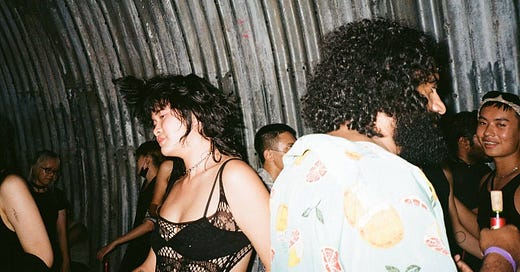







Share this post